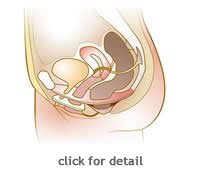Types of Incontinence
 Pelvic floor muscles play an important role in bladder and bowel functions. As seen in the diagram, your pelvic floor musculature is located at the base of your pelvic region, controlling your bladder, bowels, and vaginal area.
Pelvic floor muscles play an important role in bladder and bowel functions. As seen in the diagram, your pelvic floor musculature is located at the base of your pelvic region, controlling your bladder, bowels, and vaginal area.
The two most common types of urine leakage in women are urge and stress incontinence. People with both stress and urge incontinence are said to have mixed incontinence.
Urge incontinence
Urge incontinence is the leakage of urine associated with a strong urge to urinate, or not making it to the bathroom in time. When leakage of urine is accompanied by a sensation of the need to urinate, or the impending sense that a large leak is going to happen, this is often what is known as urge incontinence. Unlike stress incontinence, this usually represents a bladder "squeeze" or contraction, occurring at an unwelcome time. Often people with urge incontinence also have increased urinary frequency, have to rush to the bathroom frequently, or wake up more than once or twice at night to urinate. They may also notice severe urgency and leakage when driving into the driveway, placing the key in the front door, running water or with temperature changes.
Stress incontinence
Stress urinary incontinence is loss of urine that occurs at the same time as physical activities that increase abdominal pressure (such as sneezing, coughing, laughing, and exercising). These activities can increase the pressure within the bladder, which behaves like a balloon filled with liquid. The rise in pressure can push urine out through the urethra, especially when the support to the urethra has been weakened. This is what we call stress urinary incontinence. Often the stretching of pelvic muscles during pregnancy and childbirth can cause urinary incontinence in new mothers, which may or may not resolve within a few months after delivery.
Mixed incontinence
Mixed incontinence is the combination of two or more causes, such as the presence of both stress and urge incontinence.
Overactive bladder
People with overactive bladder have a sudden, overwhelming urge to urinate, but may or may not leak urine before getting to the toilet. People with overactive bladder often have urgency to go to the bathroom during the day and/or night.
Source: http://www.mypelvichealth.org.





